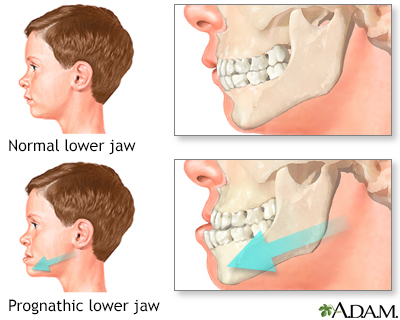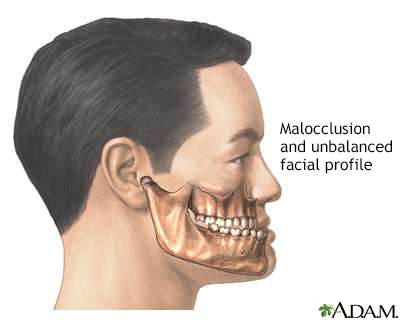Prognathism
Definition
Prognathism is an extension or bulging out (protrusion) of the lower jaw (mandible). It occurs when the teeth are not properly aligned due to the shape of the face bones.
Alternative Names
Extended chin; Underbite
Considerations
Prognathism may cause malocclusion (misalignment of the biting surfaces of the upper and lower teeth). It can give a person an angry, or fighter's appearance. Prognathism may be a symptom of other syndromes or conditions.
Causes
An extended (protruding) jaw can be part of a person's normal face shape that is present at birth.
It can also be caused by inherited conditions, such as Crouzon syndrome or basal cell nevus syndrome.
It may develop over time in children or adults as the result of excess growth in conditions such as gigantism or acromegaly.
When to Contact a Medical Professional
A dentist or orthodontist may be able to treat abnormal alignment of the jaw and teeth. Your primary health care provider should also be involved to check for underlying medical disorders that can be associated with prognathism.
Contact a provider if:
- You or your child have difficulty talking, biting, or chewing related to the abnormal jaw alignment.
- You have concerns about jaw alignment.
What to Expect at Your Office Visit
The provider will perform a physical exam and ask questions regarding your medical history. Questions may include:
- Is there any family history of an unusual jaw shape?
- Is there difficulty talking, biting, or chewing?
- What other symptoms do you have?
Diagnostic tests may include:
- Skull x-ray (panoramic and cephalometric)
- Dental x-rays
- Imprints of the bite (a plaster mold is made of the teeth)
This condition may be treated with surgery. An oral surgeon, plastic facial surgeon, or ENT specialist may perform this surgery.
Gallery


References
Dhar V. Malocclusion. In: Kliegman RM, St. Geme JW, Blum NJ, Shah SS, Tasker RC, Wilson KM, eds. Nelson Textbook of Pediatrics. 21st ed. Philadelphia, PA: Elsevier; 2020:chap 335.
Goldstein JA, Baker SB. Cleft and craniofacial orthognathic surgery. In: Rodriguez ED, Losee JE, Neligan PC, eds. Plastic Surgery: Volume 3: Craniofacial, Head and Neck Surgery and Pediatric Plastic Surgery. 4th ed. Philadelphia, PA: Elsevier; 2018:chap 28.
Koroluk LD. Adolescent patients. In: Stefanac SJ, Nesbit SP, eds. Diagnosis and Treatment Planning in Dentistry. 3rd ed. St Louis, MO: Elsevier; 2017:chap 16.